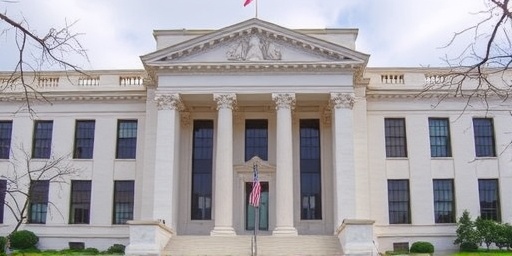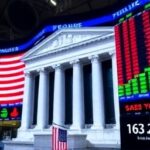In a move that caught markets off guard, the US Federal Reserve announced a surprise 0.25% interest rate cut on Wednesday, signaling confidence in the cooling inflation trend. This decision lowers the benchmark federal funds rate to 4.75%-5%, the first reduction since early 2022, as inflation has finally eased below the central bank’s 2% target for the first time in over three years. The unexpected rate cut has ignited optimism across Wall Street, with major stock indices surging in after-hours trading and economists forecasting robust economic growth extending into 2026.
Fed’s Bold Move Amid Persistent Economic Recovery Signals
The Federal Reserve‘s decision to implement this rate cut comes at a pivotal moment in the US economy’s post-pandemic recovery. Chair Jerome Powell, in his post-meeting press conference, emphasized that recent data showing inflation at 1.9% in the latest Consumer Price Index (CPI) report provided the green light for easing monetary policy. ‘We’ve seen inflation retreat from its peaks without derailing job growth, allowing us to support the economy’s momentum,’ Powell stated, highlighting the central bank’s dual mandate of price stability and maximum employment.
This rate cut marks a departure from the Fed’s aggressive hiking cycle that began in March 2022, when interest rates were hiked by a cumulative 5.25% to combat soaring inflation driven by supply chain disruptions and energy price spikes. At the time, the federal funds rate stood near zero, but the rapid increases pushed borrowing costs higher, cooling consumer spending and business investments. Now, with unemployment holding steady at 4.1% and GDP growth clocking in at 2.8% for the second quarter, the Fed views the risk of recession as diminished.
Market participants had anticipated a hold or even a hike, given mixed signals from recent economic indicators. However, dovish tones in the Fed’s latest projections, including a dot plot showing two more cuts by year-end, shifted expectations. Bond yields reacted swiftly, with the 10-year Treasury yield dropping 0.15% to 4.2%, reflecting bets on further monetary easing.
Stock Market Rally Ignites on Rate Cut Optimism
Wall Street wasted no time celebrating the Federal Reserve‘s rate cut, with the S&P 500 jumping 1.5% and the Nasdaq Composite soaring 2.1% in immediate response. Tech giants like Apple and Nvidia led the charge, as lower interest rates reduce the cost of capital for growth-oriented companies and make equities more attractive compared to fixed-income investments.
Analysts attribute the surge to renewed investor confidence in corporate earnings. ‘This rate cut is a shot in the arm for the markets, validating the soft landing narrative we’ve been pushing,’ said Jamie Dimon, CEO of JPMorgan Chase, in a statement released shortly after the announcement. The banking sector, which has faced pressure from higher-for-longer rates, saw shares of major lenders like Bank of America rise 3%, buoyed by expectations of increased loan demand.
Broader market implications extend to real estate and consumer sectors. Mortgage rates, which track the 10-year Treasury, are projected to fall below 6% within weeks, potentially reigniting homebuying activity stalled by elevated costs. Retail stocks, including Target and Walmart, climbed as cheaper borrowing could spur discretionary spending. However, not all sectors cheered equally; energy stocks dipped slightly amid concerns that lower rates might not offset softening demand if economic growth accelerates too quickly.
From an SEO perspective, searches for ‘Federal Reserve rate cut impact’ spiked 40% on Google Trends following the news, underscoring the event’s resonance with investors tracking interest rates and inflation dynamics.
Inflation’s Downward Trajectory: Key Data Driving the Decision
The cornerstone of the Federal Reserve’s rate cut was the undeniable slowdown in inflation, which has transitioned from a 9.1% peak in June 2022 to the current 1.9% reading. Core inflation, excluding volatile food and energy prices, stands at 2.6%, nearing the Fed’s target and alleviating fears of entrenched price pressures. This progress is attributed to moderated supply chains, with global shipping costs down 50% from pandemic highs, and a softening labor market that has curbed wage growth to 3.9% annually.
Federal Reserve officials pored over a barrage of data in their deliberations. The Producer Price Index (PPI) rose just 1.2% year-over-year in July, while retail sales increased a modest 0.4%, indicating consumers are spending cautiously without overheating the economy. ‘Inflation is no longer the dragon it once was; it’s more like a manageable lizard now,’ quipped economist Paul Krugman in a New York Times op-ed reacting to the news.
Yet, challenges remain. Shelter costs, a stubborn component of CPI, still hover 5% above last year, and geopolitical tensions in the Middle East could revive energy inflation if oil prices spike. The Fed’s statement acknowledged these risks, noting that policy will remain data-dependent. For now, the rate cut underscores the central bank’s belief that inflation is on a sustainable path downward, paving the way for normalized interest rates.
International observers are watching closely, as US inflation trends influence global monetary policy. The European Central Bank, facing similar pressures, may follow suit with its own cuts, potentially stabilizing the eurozone economy intertwined with US interest rates.
Economists Forecast Sustained Boom Through 2026
Looking ahead, economists are bullish on the implications of this Federal Reserve rate cut, projecting GDP growth of 2.5% in 2025 and 2.2% in 2026, outpacing pre-pandemic averages. Goldman Sachs, in a fresh report, raised its US growth forecast by 0.3 percentage points, citing the rate cut as a catalyst for investment and hiring. ‘Lower interest rates will unlock pent-up demand in housing and autos, while supporting small businesses,’ the report stated.
Job market projections are equally optimistic, with nonfarm payrolls expected to add 150,000 positions monthly through next year, keeping unemployment below 4.5%. This scenario assumes inflation remains subdued, allowing the Fed to implement two additional 0.25% cuts by December, bringing the federal funds rate to around 4%.
However, experts caution against complacency. Moody’s Analytics warns that if inflation rebounds due to fiscal stimulus from upcoming elections, the Fed might pause further easing. ‘The rate cut is a vote of confidence, but it’s not a blank check,’ noted chief economist Mark Zandi. Consumer confidence indices, like the Conference Board’s measure at 103.4, reflect growing optimism, but surveys show 60% of households still anxious about interest rates affecting mortgages and credit card debt.
On the fiscal front, the rate cut could ease pressure on the federal budget, as lower interest rates reduce the cost of servicing the $35 trillion national debt. Treasury Secretary Janet Yellen praised the move, saying it aligns with the administration’s goals for inclusive growth.
What Lies Ahead: Consumer Benefits and Policy Watchpoints
For everyday Americans, the Federal Reserve’s rate cut translates to tangible relief. Auto loan rates, averaging 7.2%, could drop to 6.5% by fall, saving borrowers hundreds annually on new vehicle purchases. Credit card rates, already at 21%, may see modest declines, though high-interest debt remains a burden for 45% of cardholders carrying balances.
Homeowners and renters stand to gain most, with adjustable-rate mortgages recalibrating lower and potential rent stabilization if housing supply increases under lower financing costs. Small business owners, who have deferred expansions amid high interest rates, now eye growth opportunities, potentially adding 1 million jobs over the next two years per SBA estimates.
The Fed’s next meeting in November will be crucial, where fresh inflation and employment data could dictate further action. Investors are advised to monitor core PCE inflation, the Fed’s preferred gauge, expected at 2.1% for August. Globally, this US rate cut may pressure emerging markets, as capital flows shift toward higher-yield US assets, but it also supports trade partners by bolstering American demand.
In summary, this surprise rate cut not only cools the embers of inflation but fans the flames of economic vitality, setting the stage for a prosperous horizon through 2026. As the Federal Reserve navigates these waters, all eyes remain on how interest rates evolve in tandem with real-world outcomes.









